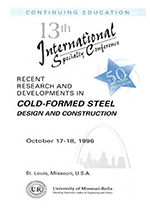Session Dates
17 Oct 1996
Abstract
Purlin-sheeting systems used for roofs and walls commonly take the form of cold-formed channel or zed section purlins, screw-connected to corrugated sheeting. This paper presents two nonlinear elasto-plastic finite element models, capable of predicting the behaviour of purlin-sheeting systems without the need for either experimental input or over simplifying assumptions. The first model incorporates both the sheeting and the purlin while the second, a simplified version of the first model, includes only the purlin. Both models are able to account for cross-sectional distortion of the purlin, the flexural and membrane restraining effects of the sheeting, and failure of the purlin by local buckling or yielding. The validity of the models is shown by their good correlation with experimental results.
Department(s)
Civil, Architectural and Environmental Engineering
Research Center/Lab(s)
Wei-Wen Yu Center for Cold-Formed Steel Structures
Meeting Name
13th International Specialty Conference on Cold-Formed Steel Structures
Publisher
University of Missouri--Rolla
Document Version
Final Version
Rights
© 1996 University of Missouri--Rolla, All rights reserved.
Document Type
Article - Conference proceedings
File Type
text
Language
English
Recommended Citation
Kitipornchai, S.; Lucas, R. M.; and Al-Bermani, F. G. A., "Modeling of Cold-formed Purlins-sheeting Systems" (1996). CCFSS Proceedings of International Specialty Conference on Cold-Formed Steel Structures (1971 - 2018). 2.
https://scholarsmine.mst.edu/isccss/13iccfss/13iccfss-session7/2
Modeling of Cold-formed Purlins-sheeting Systems
Purlin-sheeting systems used for roofs and walls commonly take the form of cold-formed channel or zed section purlins, screw-connected to corrugated sheeting. This paper presents two nonlinear elasto-plastic finite element models, capable of predicting the behaviour of purlin-sheeting systems without the need for either experimental input or over simplifying assumptions. The first model incorporates both the sheeting and the purlin while the second, a simplified version of the first model, includes only the purlin. Both models are able to account for cross-sectional distortion of the purlin, the flexural and membrane restraining effects of the sheeting, and failure of the purlin by local buckling or yielding. The validity of the models is shown by their good correlation with experimental results.



